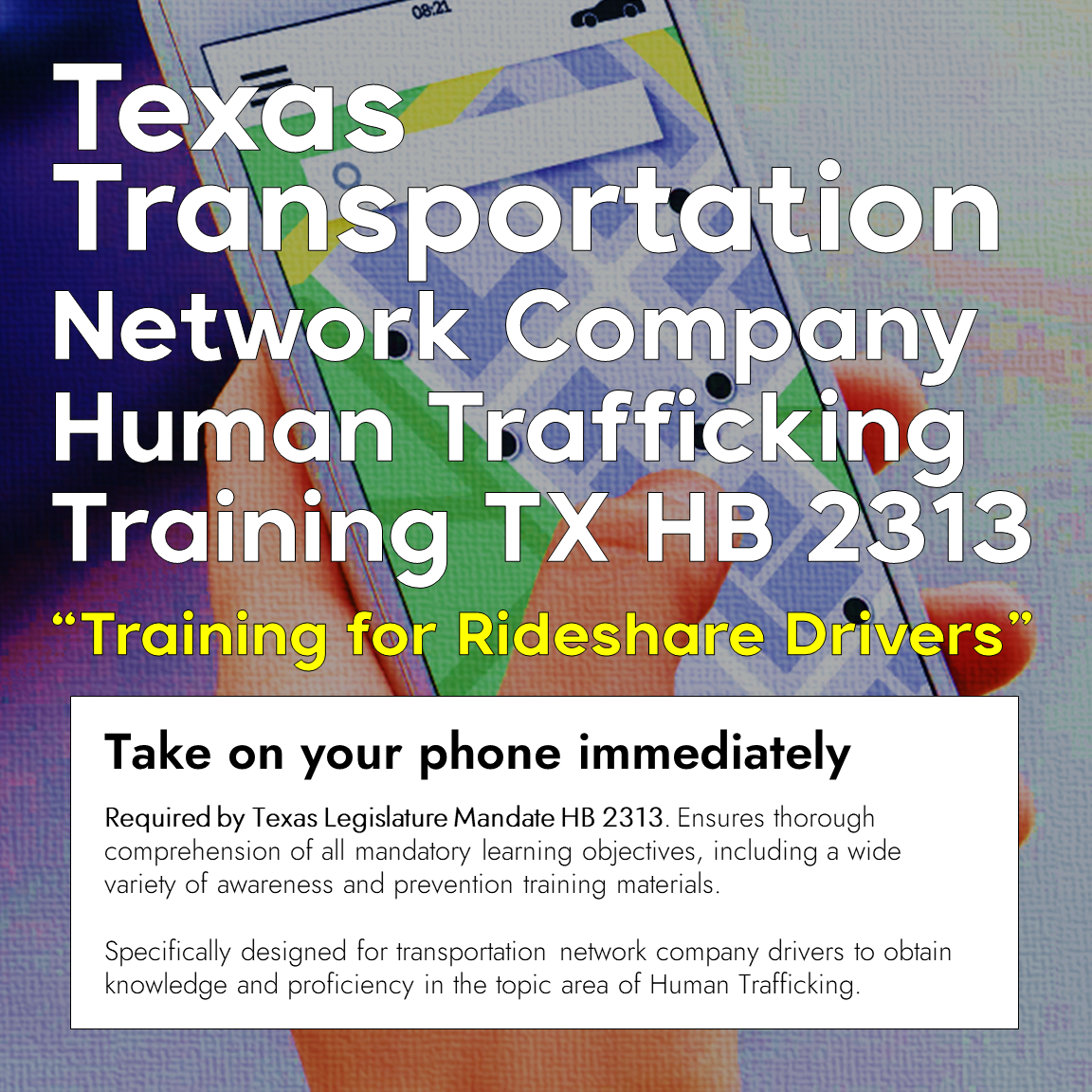Texas Transportation Network Company Human Trafficking Training TX HB 2313
$24.99
Training for Rideshare Drivers
Specifically designed human trafficking awareness and prevention training for transportation network drivers.
Texas Transportation Network Company Human Trafficking Training TX HB 2313 is a self-contained course that dramatically exceeds Texas’ learning objective requirements, and includes an overview of human trafficking, guidance on how to identify individuals who are most at risk for human trafficking, and explains the role of drivers in reporting and responding to human trafficking..
.
Please contact [email protected] to learn more
Out of stock
- Satisfaction Guaranteed
- No Hassle Refunds
- Secure Payments
In Brief
The training includes an overview of human trafficking, guidance on how to identify individuals who are most at risk for human trafficking, and explains the role of drivers in reporting and responding to human trafficking.
Transportation Industry Awareness
- Driver receives an email demonstrating a passing score (over 70%) or a Mastery Certificate (100%) upon completion of final assessment at the end of the course
- Duration: 20+ minutes
- English and Spanish language versions included
Employer recommendations
- Must be completed by a driver before they are authorized to log in to the digital network of a Transportation Network Company, such as Uber or Lyft
- Read news article here. Read requirements from the Texas Attorney General here.
Learning objectives
- An overview of human trafficking;
- How to identify who is most at risk for human trafficking;
- The difference between labor and sex trafficking when identifying human trafficking in the transportation industry;
- The employee’s role in reporting and responding to human trafficking; and
- Contact information for reporting human trafficking.
Mandatory training requirements are integrated into multiple learning modalities used throughout the interactive course. Learning objectives are woven throughout mixed media, audio, video, graphics, descriptive stories, downloadable resources, written lessons, interactive activities, a Pre-Course Assessment, and practice tests. Students are challenged to take an assessment-based Final Certificate Exam to demonstrate mastery of the material.
Training Design
- The training excludes sensationalized imagery, bias, prejudice, or confidential information.
- The training includes the experience of human trafficking victims
- The training content is evidence-based and free from factual errors. If statistics are used, there should be a citation and references to where these statistics were found and the date the statistic was published.
- The learning objectives are clear, and these objectives are met within the training.
- The training must cover the key components found below.
- The training material must not be less than 15 minutes in duration.
Key Components
1. The training must include an overview of human trafficking, including a description of:
- The experience of human trafficking victims;
- How human trafficking is defined under state and federal law, including the concepts of force, fraud, or coercion within the context of human trafficking.
- All major forms of trafficking (including labor, sex, adult, child), including a discussion of each form and how that relates to the identification of human trafficking in the transportation industry.
- The differences between human trafficking and smuggling;
- The differences between sex trafficking and labor trafficking.
- How and why human trafficking takes place in the transportation industry
2. Contains guidance on how to identify individuals who are most at risk for human trafficking. This should include specific red flag indicators of human trafficking, including a person who:
- Is unsure about who they are with and what they are doing.
- Does not know their final destination or did not order the transportation service for themselves.
- Appears submissive, fearful, tense, or paranoid.
- Has physical injuries or branding such as a name tattoo.
- Defers to another person when answering questions.
- Is wearing clothing is inappropriate for weather conditions or the situation.
- Possesses multiple phones or hotel room keys.
3. Provides guidance on the role of drivers in reporting and responding to human trafficking:
- The training provides guidance on the role of an employee in reporting and responding to human trafficking, including how to respond to any victims asking for assistance.
- The training lists the contact information of appropriate entities for reporting human trafficking, including the National Human Trafficking Hotline toll-free telephone number and text line, appropriate local law enforcement agencies, and a telephone number designated by the attorney general for reporting suspected human trafficking. Specifically, the training must direct the audience to call 911 in an emergency, to contact iWatchTX at iWatchTX.org or 844-643-2251 if they have information for law enforcement regarding suspicious activity related to human trafficking, and to contact the National Human Trafficking Hotline at 888-373-7888 or text 233733 regarding assistance for victims of human trafficking.
Certification & Compliance Recommendations
- The training must be approved by the OAG.
- The training must be provided to a new employee before the driver is authorized to provide prearranged rides using the company’s digital network.
- All drivers must be trained annually.
- The approved training provider must maintain records necessary to establish that the company has provided the training materials required by Section 2402.1075, Texas Occupations Code. They must further comply with any applicable rules which may be enacted by the Texas Department of Licensing and Regulation.

